
ALL MATERIAL COPYRIGHT KEVIN SCOTT 2011. LINKS TO THIS SITE ARE WELCOME BUT DO NOT COPY MATERIAL FROM THIS SITE TO ANY OTHER WEBPAGE.
If you find this site useful, please support it by making a donation of $1 to help maintain and develop it. Click on the PAYPAL DONATE button to do this safely. But there is no obligation - please avail yourself of the information and facilities of the site at no charge.
The Fortin Barometer is the most widely used, and generally most accurate of mercury barometers and while
the use of mercury is still permissible, will remain the primary absolute instrument for calibration purposes
and in all circumstances where a dependable, precise measurement of atmospheric pressure is required.
Figure 1 shows the essential features of the instrument. A glass tube T, about 10mm OD and 6mm ID, is sealed at the upper end
and is provided with a tapered lower end which projects into the the cistern C. Tube T is some 900 mm in length and is supported
by the top plate of the cistern C, by corks B, and by a slot (not shown) in the top of the brass scale housing D.
The cistern C has a lower brass section containing a leather bag, the capacity of which can be adjusted by the
screw W. The upper section of the the cistern consists of a wide glass tube clamped between the upper and lower cistern flanges
by means of the long screws P. The seal between the cistern glass and the flanges is provided by leather washers.
An ivory pin, S, is provided as an index visible through the cistern glass.
At the upper end of the instrument, the barometer tube T passes into the brass scale housing D. This consists of a brass tube
upon which is engraved a scale in millimetres being the vertical distance from the tip of the ivory pin S. A vernier
scale V is adjustable by the screw Y. The whole is arranged so that it is possible to read the vertical distance between
the tip of the ivory pin S and the lower edge of the vernier V. Parallax error in reading the position of V is avoided
by means of a plate level with and attached to V running vertically at the rear of D.
In use the vertical tube T and the cistern C are filled with mercury. The space above the mercury in T contains a Torricellian vacuum.
In order to read the prevailing atmospheric pressure, the Screw W is rotated until the tip of the ivory pin S, just touches the Mercury surface.
The wheel Y is then turned so that the lower edge of vernier V is exactly level with the top of the Mercury column M.
The height of the mercury column is read from the scale on D using the vernier V.
A ring G is provided by which to hang the instrument. A thermometer Q is located half way along the brass casing.
A Fortin barometer is usually also provided with a gimbal mount to that it may be maintained vertical. This, of course,
is especially important in marine instruments.
The quality of the Torricellian vacuum is the most important factor controlling the accuracy of a Fortin Barometer.
The accuracy of the scale is important also, but can easily be checked with a cathetometer. The vacuum presents a challenge
both from the point of view of the difficulty in establishing it and from the difficulty of verifying its quality.
The first step is to dismantle the barometer. This requires care and precautions to be taken for the collection of mercury and the safe handling of it.
The instrument is clamped vertical using a clamp on the lower part of the cistern and two other clamps at top and bottom of the barometer tube housing.
When the clamps are in place, the three long bolts P are slackened and removed. The two clamps holding the brass housing are slackened
and the brass housing carefully raised thus exposing a section of the barometer tube still resting in the cistern. The barometer tube itself should not
be lifted at all at this stage, but should be secured by the lower clamp vacated by the brass housing. When the glass barometer tube is secure, the
brass housing can be removed completely.
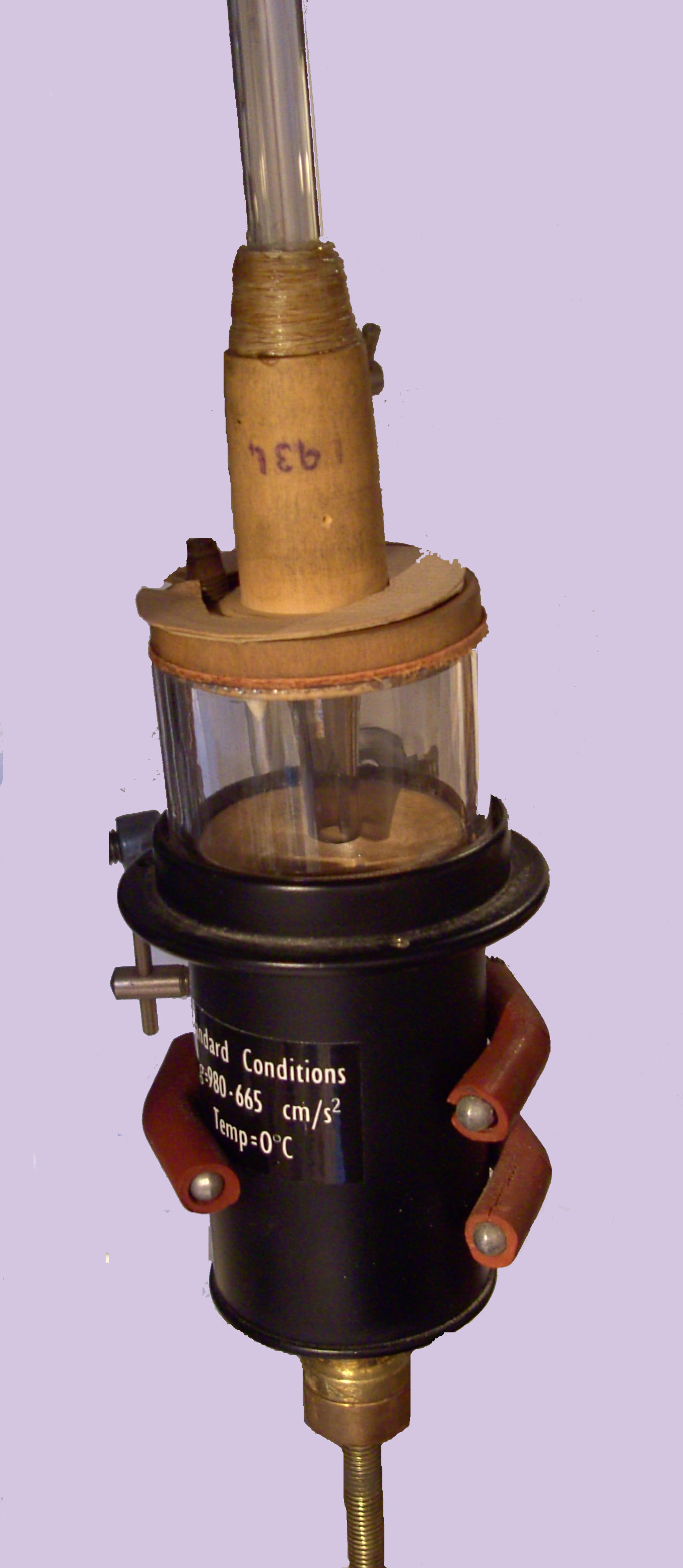 The cistern and lower
section of the barometer tube after removal of the barometer tube housing.
The cistern and lower
section of the barometer tube after removal of the barometer tube housing.
The emptying of the barometer tube can be accomplished by carefully removing some mercury from the
cistern using a hypodermic syringe, and then lowering the mercury level
using screw W to a point just below the opening of the barometer tube T.
This will admit some air into the barometer tube and some mercury will escape into the cistern.
The mercury level can be raised again W and some removed using the syringe.
Lowering the level again will admit a little more air into the
barometer tube. This process can be repeated until the barometer tube is empty.
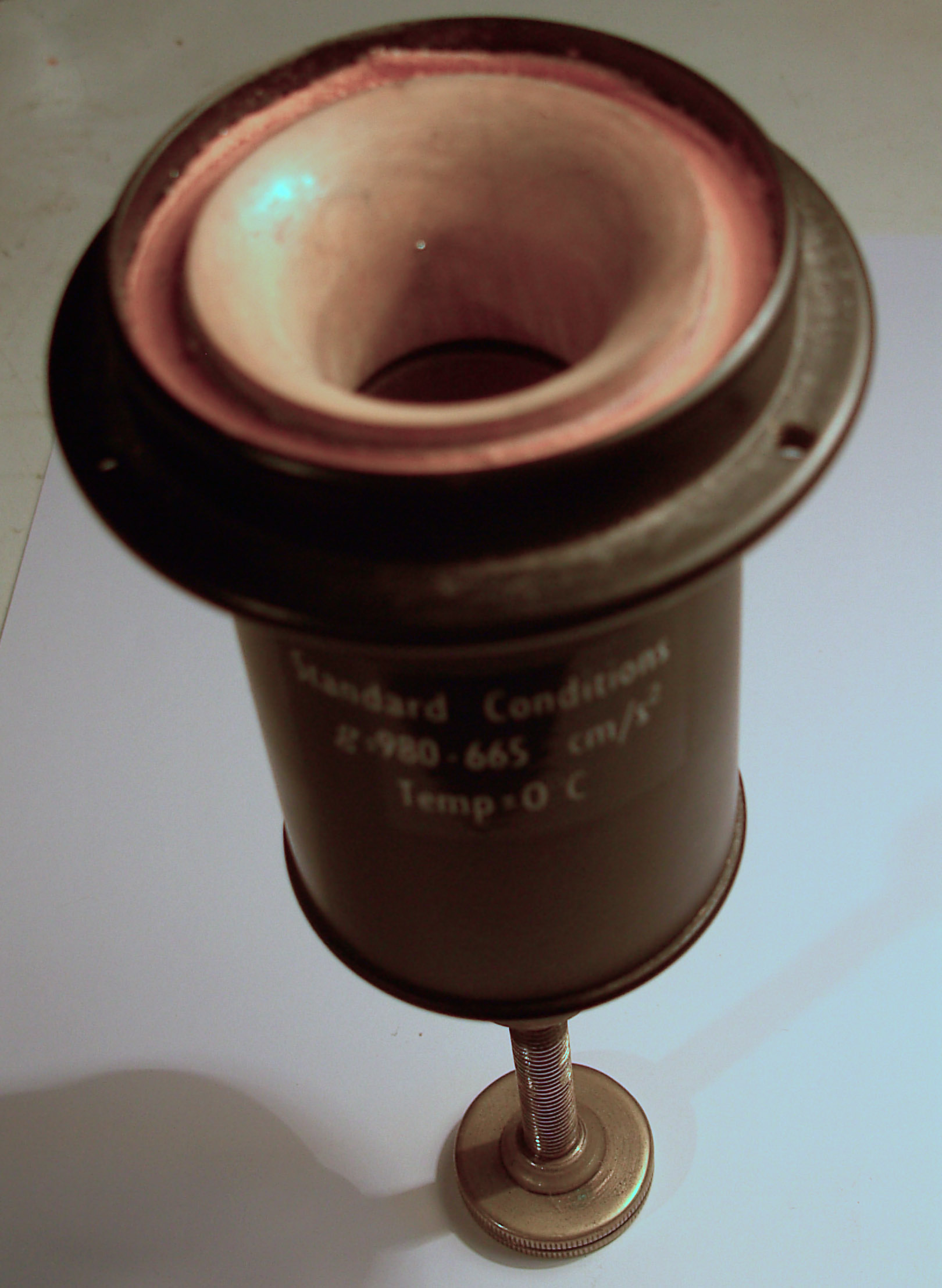 The cistern after removal of the mercury, the barometer tube
and the glass cistern tube.
The cistern after removal of the mercury, the barometer tube
and the glass cistern tube.
The Barometer tube should be cleaned with nitric acid using the technique described under Restoring a Fitzroy Barometer. It should then be washed and dried. If the mercury is to be reused is should be cleaned. Normally distillation is not necessary. Oxide and dust have to be removed and this can be done using a hypodermic syringe to draw the mercury away from the dross. The photograph shows how effective this can be. The operation can be repeated several times if necessary.
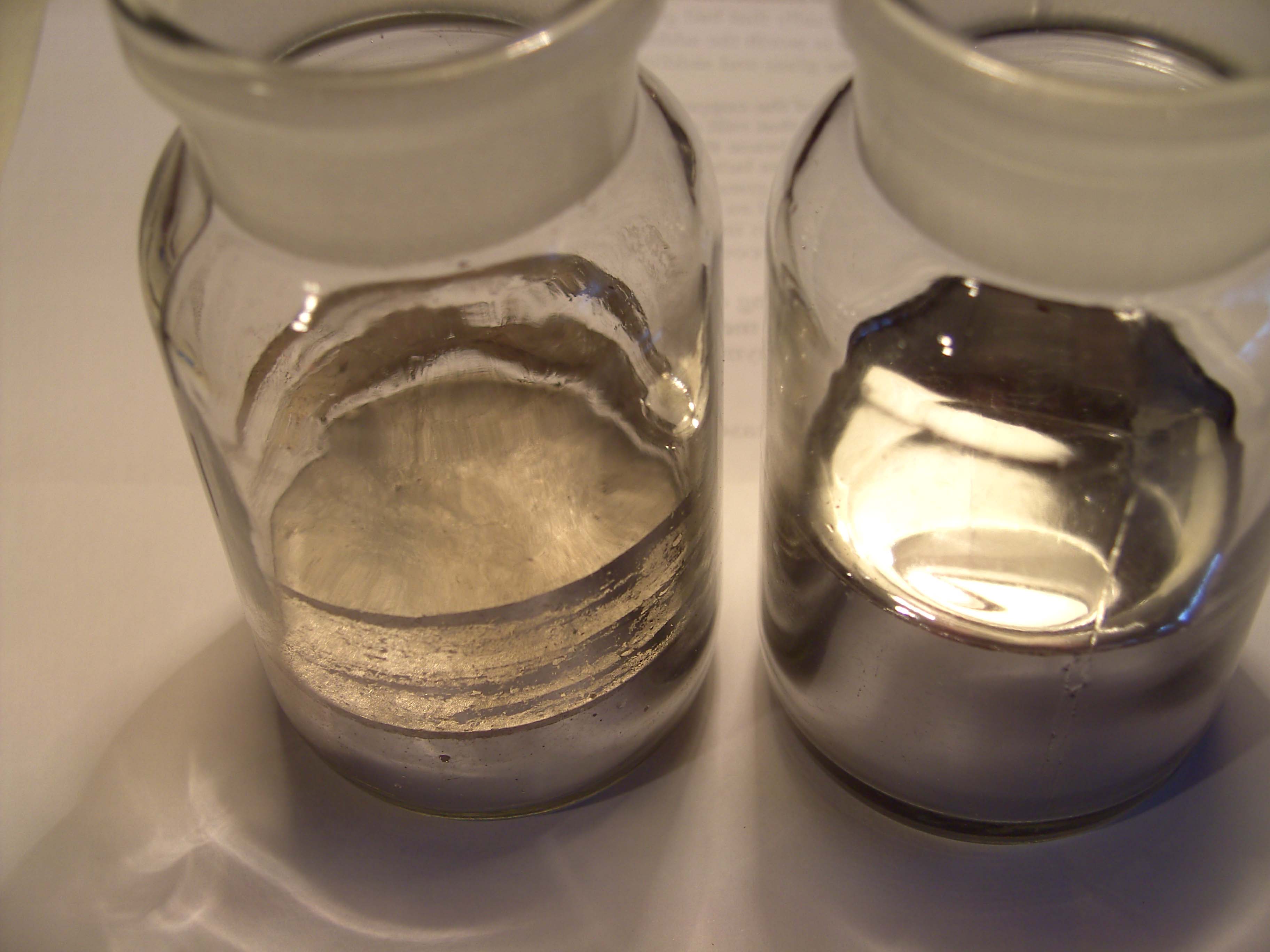 Mercury transferred from the bottle on left to that on the right, leaving the dross behind.
Mercury transferred from the bottle on left to that on the right, leaving the dross behind.
With all the mercury removed, the components of the barometer can be carefully cleaned. The leather lining to the cistern should be treated with
particular respect as the surface is relatively easily damaged. Refilling the barometer is an operation which requires great care if it is to be accomplished
correctly and the resulting barometer is to read accurately. Conceptually, it is a simple matter:
The barometer tube needs to be filled with mercury and inverted and its lower end opened under the surface of the mercury in the cistern.
Air bubbles, moisture and mechanical difficulties all conspire to give a poor result ( a boarometer which reads too low.)
Before the days of high performance vacuum pumps, barometer makers would boil the mercury throughout the entire length of the tube for 5 hours
to remove air and moisture, before inverting it over the cistern.
The availability of a good vacuum pump makes other methods possible. One such is to seal a tube on to the normally closed end of the barometer tube,
pump it down in situ, thus drawing up the mercury from the cistern. After thorough pumping, the tube is sealed off in the flame and the instrument reassembled.
Alternatively, a thin teflon tube is threaded up the barometer tube which is mounted in
its normal position and the air pumped out through the trap pictured on the left.
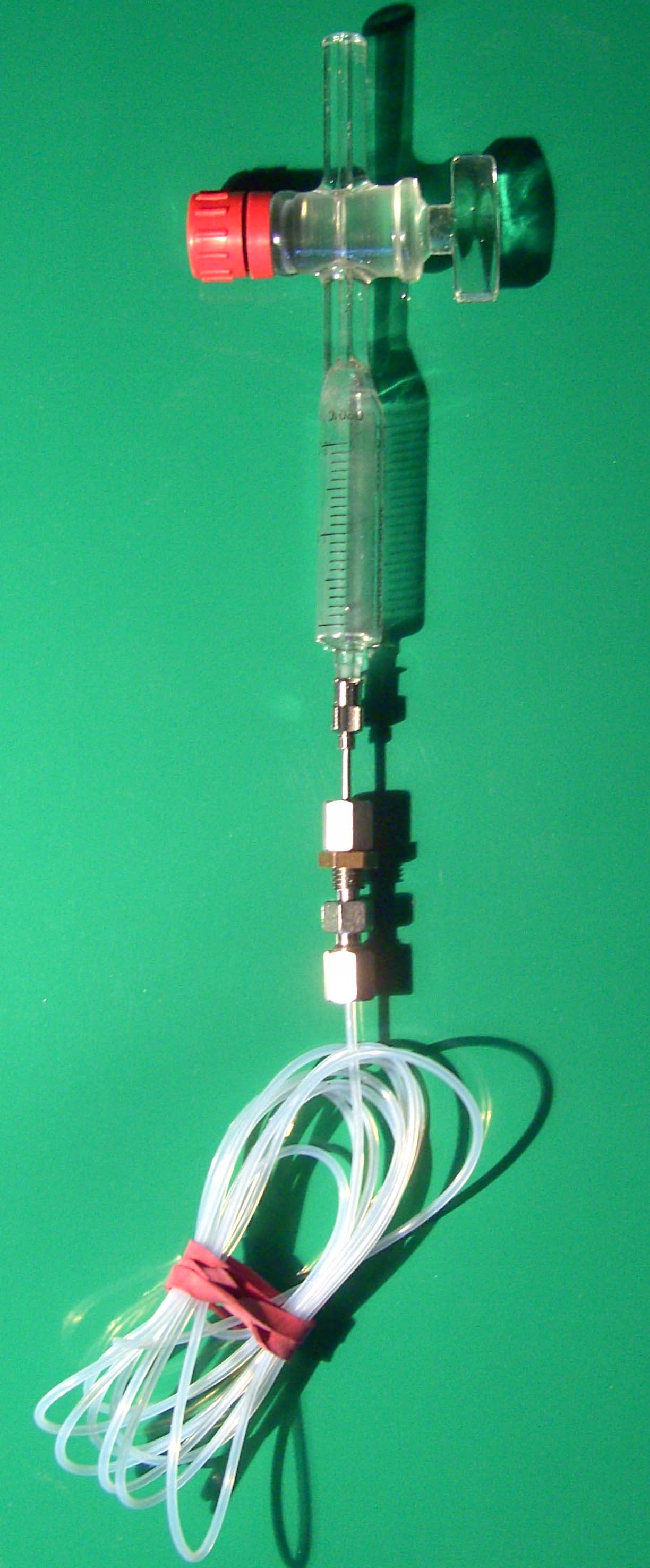 Simple device used for filling barometers using a vacuum pump.
Simple device used for filling barometers using a vacuum pump.
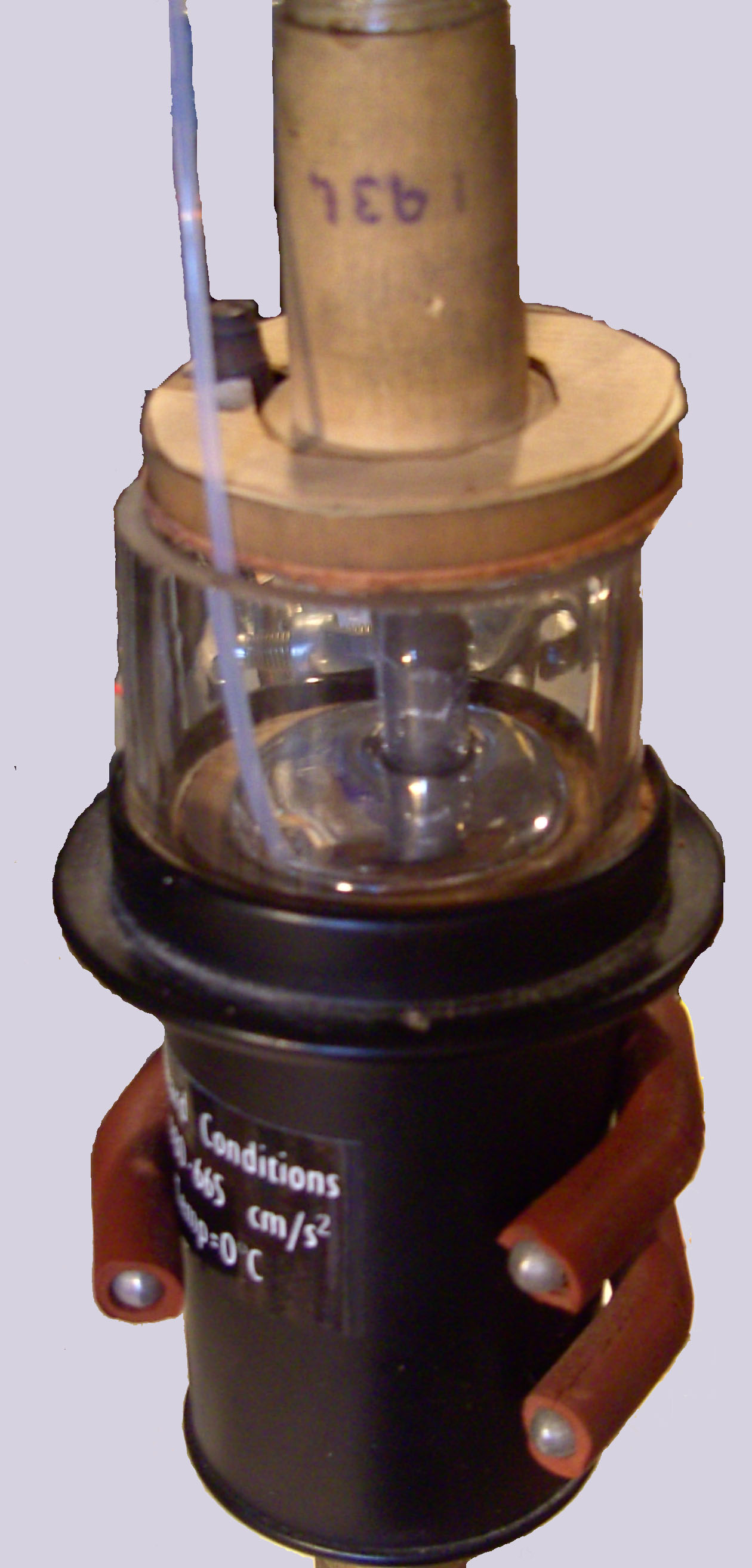 Arrangement used for filling barometer with a vacuum pump
Arrangement used for filling barometer with a vacuum pump
The evacuation is carried ount in stages: The stopcock on the trap is opened momentarily to remove some air from
the barometer tube. The level of mercury in the cistern is topped up and the process repeated until the mercury will no longer rise further in the tube.
The stopcock is then opened and the barometer pumped down for an hour. The pressure in the vacuum line is monitored using a Pirani gauge
and should be no greater than 0.05mm Mercury.
When the pumping period is over, the stopcock on the trap is closed and immediately the telflon tube is withdrawn carefully from the
barometer. The trap fills with mercury during this process. When the teflon tube has been completely withdrawn, the barometer is carefully re-assembled. The brass
housing is placed once again over the barometer tube and secured to the cistern with the long brass bolts. The level in the cistern is adjusted
by adding or removing mercury using a syringe so that the screw W enables the mercury level to reach the tip of the ivory pin
whatever the prevailing atmospheric pressure.
The barometer is once again mounted on its gimbal support.
The reading of a Fortin Barometer is straight-forward. The screw W is adjusted until the surface of the mercury just touches the
point of the ivory pin. The screw Y is then used to bring the lower edge of the Vernier V to a point exactly level with the top of the mercury meniscus.
The pressure is then read from scale D using the Vernier.
There are three corrections which need to be applied for the best accuracy: (a) a correction for temperature,
(b) a correction for variation in the acceleration due to gravity, and (c) a correction for the capillary effect of
mercury in a glass tube. For a 6mm diameter tube the capillary correction is about 0.91mm to be added to the reading. (a) & (b), however, are variable and need to be applied to the reading obtained from the Barometer.
The barometer is designed to read correctly at 0 deg C. If the linear coefficient of thermal expansion of brass
is α at temperature t, the actual pressure is higher than that indicated by a factor of (1 + α.t)
The mercury also expands with a volume coefficient of expansion of β. If the density of mercury at 0 deg C is ρ,
the density at temperature t ( deg C) is ρ(1-t.β)
If g is the local gravitational acceleration and g0 is the standard to which the barometer is calibrated (frequently 980.665 cm.sec-2) then the reading obtained needs to be corrected by the factor g/g0
To correct for temperature, gravity and capillarity the following equation can be used:


Figure 1, The anatomy of a Fortin Barometer.